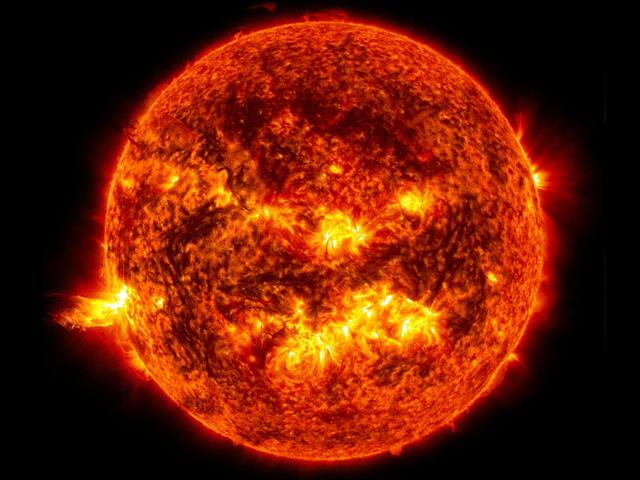Severe Solar Storm Impact Expected

OMAHA (DTN) -- The Space Weather Prediction Center (SWPC) on Nov. 11 issued a very rare G4 severe geomagnetic storm watch. This is the fourth G4 watch issued so far during the 11-year solar cycle, which began in December 2019 and is still considered in its maximum phase.
Farmers may want to keep an eye on the sky for northern lights farther south than normal Tuesday evening and the next couple of nights, but also check to see if the geomagnetic storms affect GPS on their machinery. The impact is expected to be primarily poleward of 45 degrees latitude but could cause satellite navigation (GPS) to be degraded or inoperable for hours.
The latest watch is the result of several coronal mass ejections (CMEs) of solar material and strong magnetic fields that took place Nov. 9-10. On the morning of Nov. 11, there was an X5.1 solar flare (an eruption of energy) that is rarely of this magnitude, but not necessarily unusual, stated SWPC.
It was noted that "solar flares of this magnitude can be impulsive (meaning quick to rise and decrease) lasting some minutes, or last a few hours." SWPC continued to say that users of HF radio signals could experience loss of contact or major disruptions for several minutes to a couple of hours in affected areas.
Space.com reported this was the strongest flare of 2025, and the "most intense since October 2024." The site added, "The blast triggered strong (R3-level) radio blackouts across Africa and Europe, disrupting high-frequency radio communications on the sunlit side of Earth."
NORTHERN LIGHTS POSSIBLE IN ALABAMA
When the CME arrives on Earth, it is expected to lead to highly elevated magnetic activity. "Detrimental impacts to some of our critical infrastructure technology is possible, but mitigation is possible," SWPC said on its site, adding that aurora (northern lights) "may become visible over much of the northern half of the country, and maybe as far south as Alabama to northern California."
The geomagnetic storm alert is for G4 (severe) for Tuesday evening and early Wednesday, then continuing to be strong to moderate the next couple of days. (On the G-scale, G1 is a minor storm, G5 most extreme.)
"Confidence in an Earth-component to the most recent CME is high, while timing has a moderate level of certainty. As always with these events, the intensity of the CME will not be known with better certainty until it arrives 1 million miles from Earth and is observed by the solar wind observatories at that location," explained SWPC. "It is at that point that any needed Warning decisions can be made by SWPC forecasters. So, for now, SWPC believes there is a potential for G4 levels upon CME arrival and/or as the CME passage progresses. Stay space weather aware and follow the latest information, forecasts, and updates at www.spaceweather.gov."
MAY 2024 STORM AFFECTED SEEDING
Farmers may recall that on May 10, 2024, while they were planting, they were affected by a powerful geomagnetic storm that affected Canada and the U.S.
The Kansas State University Research and Extension News Service said in a later news release about that event that it caused "mass global navigation satellite system outages ... leading to an assumed $565 million in losses for Midwestern crop producers." The K-State release added that there could still be geomagnetic disturbances for the solar cycle in fall 2025 and even spring 2026.
The sun is the main source of space weather. Radio emissions, coronal mass ejections (CMEs), and solar flares are some of the causes of geomagnetic storms.
Storms are more common during solar maximums. The peak of sunspot activity is known as a solar maximum. The lull is known as solar minimum. Maximums and minimums occur on average in 11-year cycles. Earth is approaching the peak of the current solar maximum that began in 2019. The peak should occur in summer 2025, although some experts are now speculating this solar maximum could last into next year.
Radio-frequency-disrupting flares reach Earth at the speed of light. CMEs usually travel more slowly, taking one to five days to reach Earth. Space.com said the CME released Tuesday was speeding toward the earth at 4.4 million mph. Both CMEs and flares can disrupt communications, the power grid, navigation, radio and satellite operations for minutes, to hours or days at a time.
IMPACT ON GPS, WHAT FARMERS CAN DO
A complete loss of signal lock by the GPS receiver due to extreme noise from the upper atmosphere (primarily nighttime) can result in no location data for an interval of time. Noise introduced by the upper atmosphere also could have induced errors in the calculated position.
Like a thunderstorm, farmers can only manage their systems through GPS-battering geomagnetic storms. Newer positioning systems that lock onto multiple satellite constellations are little to not affected by solar storms.
With older navigation systems, farmers may bring a stop to fieldwork and wait for the storm to pass, often in hours. Or farmers can grab the steering wheel and just plow through, accepting crooked rows of fieldwork and any planting, harvesting and data collection inaccuracies that follow.
But without GPS, the as-planted data (as-sprayed, as-fertilized, as-harvested) cannot be logged onto a map or georeferenced. This isn't just a negative result for farm operators. Seed suppliers and local agronomists rely upon these data for upstream use.
Here are specific actions you can take.
-- Understand what part of any equipment or data system relies on GPS or radio frequencies (RF), and how resilient that equipment is to RF/GPS noise. Are your GPS receivers single or dual frequency receivers? Single frequency receivers are more susceptible to space weather.
-- Have a short-term local data backup system. Similar to a commercial security system that records everything and then deletes it after a certain period, data would go to both the cloud and a short-term, local backup system that could be recovered if the connection to the cloud is compromised.
-- Sign up for space weather alerts/watches/warnings at the NOAA Space Weather Prediction Center. Go to https://www.swpc.noaa.gov/… or just to www.swpc.noaa.gov.
-- If an issue is noticed with the GPS systems look at the NOAA alerts or the Navigation Centers civilian GPS outage reports (https://www.navcen.uscg.gov/…) to determine whether the source is environmental or a hardware problem.
-- If there is elevated space weather, and local hardware issues have been ruled out, report outage to the Navigation Center through the on-line reporting: https://www.navcen.uscg.gov/….
It is important that the nation has a good understanding of how space weather affects users -- including farmers.
For the complete K-State Research and Extension release featuring Griffin go to: https://ksre-learn.com/…
Elaine Shein can be reached at elaine.shein@dtn.com
Follow her on social platform X @elaineshein
Progressive Farmer Senior Editor Dan Miller also contributed to this story with archived coverage.
(c) Copyright 2025 DTN, LLC. All rights reserved.







